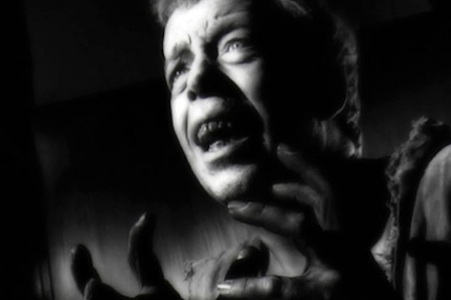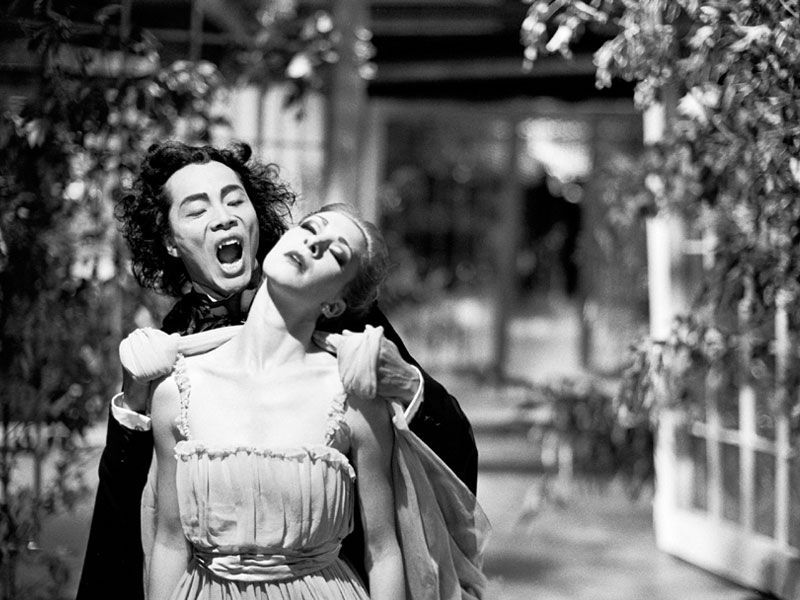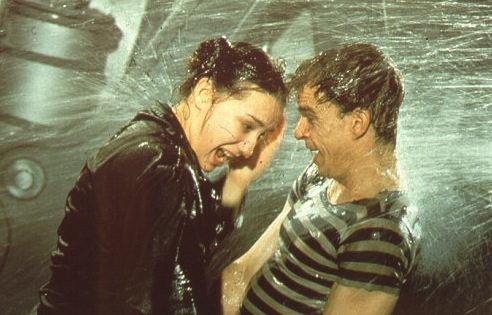4. Sleep (1963, Andy Warhol)
Warhol shot his boyfriend John Giorno sleeping—for over five hours. No sound was recorded, not that it would’ve made much of a difference. Warhol went further, of course, with eight noiseless hours of Empire, but the reality is that the avant-garde, or “experimental” film, going back to the ’30s, often existed in a sound-free realm.
5. Monsieur Hulot’s Holiday (1953, Jacques Tati)
Again, the rules will have to be clarified: Tati’s classic comedy had sound, all of it either merely physical effects or aurally indistinct, constructed almost entirely in the recording studio, but without any discernible or vital dialogue. Sort of like watching a 1920s silent farce with an active orchestra and participating audience.
6. Juha (1999, Aki Kaurismaki)
Finnish master Kaurismaki’s dour, catatonic comedies made him a famous festival darling, but this silent melodrama, in which AK axiom Kati Outinen leaves her husband’s farm only to be converted into an urban whore, barely got seen. Even so, it’s not terribly different than Kaurismaki’s best films, which have always been oddly close to the purity and humanity of silent cinema all along.
7. Sidewalk Stories (1990, Charles Lane)
Lane’s Spike Lee-era indie paid homage to Chaplin’s The Kid but in the scrubbier neighborhoods of New York during the Giuliani years. The silence is transgressed in the very end, with real homeless men audibly begging passersby for change, but by that time you hardly see the need for any sound at all.
8. Hotel Monterey (1972, Chantal Akerman)
Akerman’s debut feature is Warholian in its astringency—with no soundtrack of any kind, we get what is essentially a still-life, a portrait of the eponymous hotel, a rundown, claustrophobic single-occupancy dwelling for transients and fringe dwellers. Shooting over the course of a single, long night, Akerman moves from the lobby, where patrons and employees are glimpsed but apparently oblivious to being filmed, to the elevator to the rooms and hallways, filmed in symmetrical Kubrick-like compositions, sometimes empty, sometimes occupied by what are obvious loners looking to be forgotten by society. Genuinely spooky.
9. Pushpaka Vimana (1987, Singeetham Srinivasa Rao)
An Indian action-comedy about a penniless kid kidnapping a drunken millionaire. Think for a moment about how difficult it must’ve been to make this film in the Indian film industry, which is ordinarily so combustible with manic soundtrack energy that even the cancer melodramas have musical dance numbers.
10. Tuvalu (1999, Veit Helmer)
German director Helmer’s bizarre debut, set entirely in a mythical and decaying public bathhouse, belongs in the hyper-designed, absurdist landscape of Caro & Jeunet’s Delicatessan, but it’s doped on blooming whimsey, not violence and sex. Every modern maker of neo-silents should have Helmer’s advantage here: French demi-star Denis Lavant, a troll-like acrobat of a man who may well have been a Lon Chaney-style sensation had he been alive between the world wars.
11. The Call of Cthulhu (2005, Andrew Leman)
Evoking antique form and a sense of primal matinee naivete, Leman’s microindie is scrupulously faithful to H.P. Lovecraft’s seminal Cthulhu tale (first published in 1928), runs only 47 minutes, and packs enough storytelling and energetic incident to fill out a mini-series. Leman and his H.P. Lovecraft Historical Society cohorts cut every corner and freely employ obvious miniatures to tell the tale-within-a-tale-within-a-tale, from the Providence streets all the way to the unmapped Pacific atoll covered with enigmatic ruins (cardboard, mostly), and the stop-motion appearance of the Old God himself. Call it pulp-geek nostalgia, but the movie also actually manages to be creepy, in a cheap, unstable, kids-pretending-in-the-woods kind of way. It is innocent, and that alone makes it special.
12. Silent Life (2012, Vlad Kozlov)
Yet to be released, this low–budget all-silent biopic of ’20s screen idol Rudolph Valentino has been in production for four years (predating The Artist? who can say?), but desperate-unknown writer-director-star Kozlov has promised it out by the end of this year. Breath needn’t be held; plenty of Valentino’s actual films are available wherever real cinema is sold.








